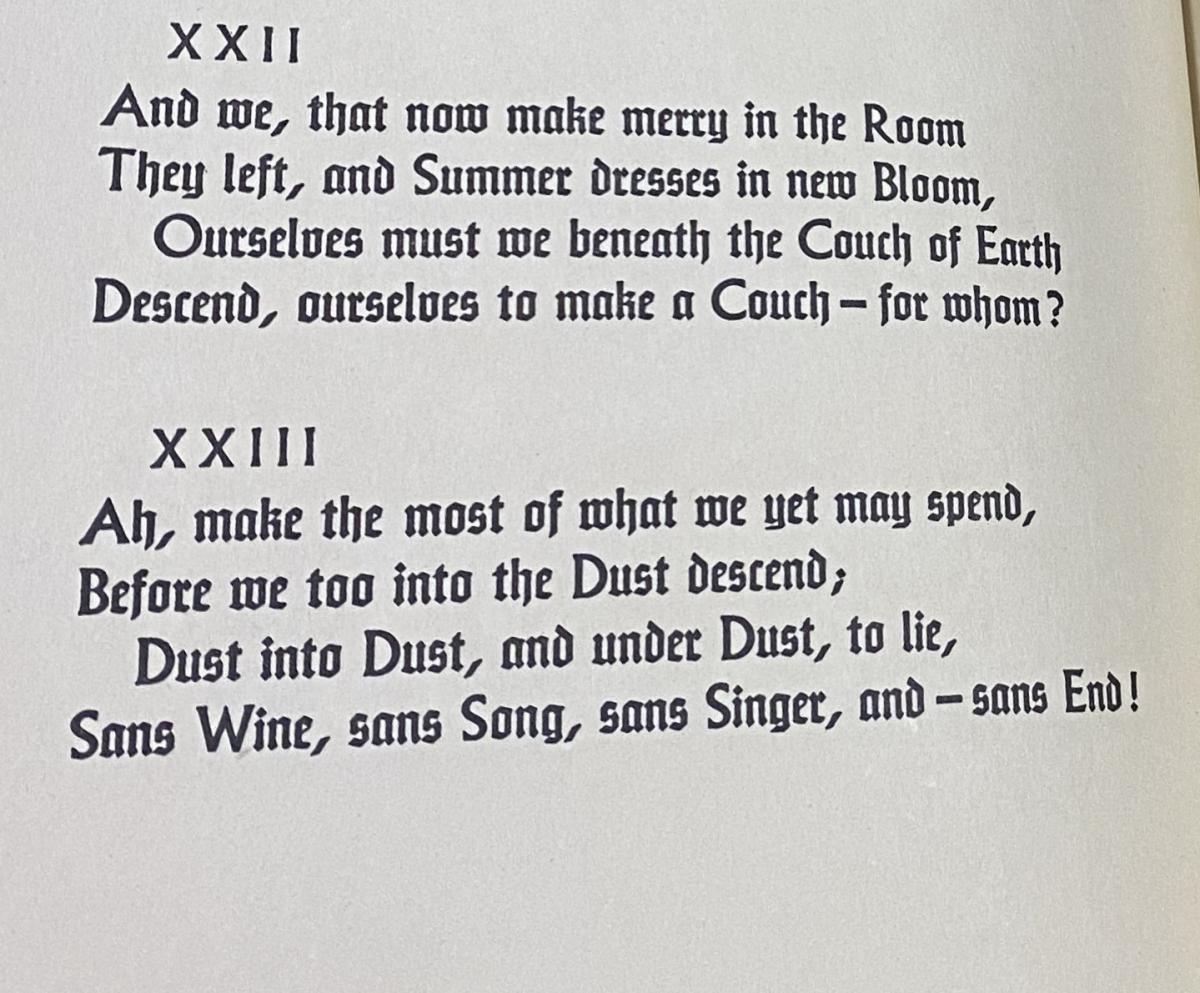While this 1946 First Edition FitzGerald's translation of the Rubáiyát of Omar Khayyám has many beautiful images illustrationed by Arthur Szyk, there is one in particular with accompanying quatrains that embody the text. For this particular examination, I will focus on Quatrain XXIII and the correlating image. Quatrain XXIII (Figure 1) is one of four stanzas accompanied by an image of a man and woman lounging at leisure under a tree, seemingly. The stanza reads:
Ah, make the most of what we yet may spend,
Before we too into Dust descend;
Dust into Dust, and under Dust, to lie,
Sans Wine, sans Song, sans Singer, and - sans End!
Based on my interpretation of this reading, the overall message of Quatrain XXIII is to live in the present and live each day to the fullest, a common theme that frequently emerges in the Rubáiyát of Omar Khayyám. As we break this stanza apart, we get to determine how it connects to the imagery presented in the illustration, as well as how it continues said theme. To do so, we must analyze each line. The first line reads, Ah, make the most of what we yet may spend.
The first line reads, Ah, make the most of what we yet may spend. Rather than a word, the line begins with a sound. The sound, Ah, is an expression often used to signal satisfaction or wonder. In this case, it is a little of both. The speaker is expressing a feeling of wonder and satisfaction. This expression emphasizes the rest of the line - make the most of what we yet may spend. He is showing his readers how short time can be and how each day should be lived to its fullest potential and that the time given to us should be used to explore wonders and satisfy the self.
When we relate this text to the image, the words that pop out the most are - of what we yet may spend. This translates to all of the elements and objects Earth has to offer, all of which are conveniently surrounding the man and woman, who seem to be basking in all. Notice specific objects in the illustration: A beautiful summer setting filled with sweet bird songs and gentle animals. The man and women are resting in the shade, drinking wine from golden chalices, and surrounded by all nature has to offer (note that nature is another reoccurring theme). A couple of particular items that stand out are the golden treasures, the food, and the small book they are reading, presumably the Rubáiyát itself. Looking back at our reading of Black's interpretation of FitzGerald's translation of the Rubáiyát of Omar Khayyám, these items are a nearly exact representation of her observations, down to the small book.
The second line of the quatrain reads - Before we too into Dust descend. This line suggests that all the wonders around them will someday be gone forever. All the beautiful wonders and treasures will turn to dust. As will we. That is why they must be enjoyed now while there is still a chance to enjoy them.
Dust into Dust, and under Dust, to lie, - This statement implies that everything will eventually die, or cease to exist. This puts even more emphasis on the quatrain's previous line. There is also an underlying theme that emerges around life and death: One doesn't know how much time they have, and tomorrow isn't guaranteed. All the more reason to live the present day to its fullest and experience all it has to offer. We will someday lie under the very dust we, and the world, become.
The last line of Quatrain XXIII reads, Sans Wine, sans Song, sans Singer, and - sans End! It is the final reiteration of the entire stanza, and all the image holds. Without wine, without song, without singers of song, and without end - This is a very specific telling of what will no longer be. The author is once again relaying to his readers what is at stake, but by using specific examples of the luxurious items pictured in the illustration, his words become more impactful.
Khayyám Omar. The Rubáiyát of Omar Khayyám Rendered in English Verse by Edward FitzGerald. The Heritage Press, New York. Copyright 1946. Illustrations by Arthur Szyk. Sun Engraving Company. Franfare Press, London.



